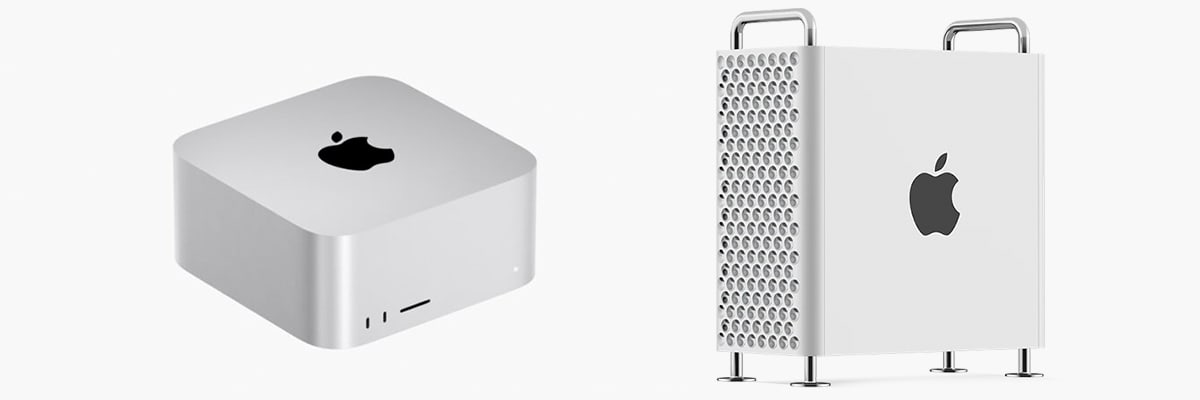
Return navigate_next
Comparing the New Mac Studio to the Mac Pro Desktop
March 28, 2022 *
As arguably the world’s most popular electronics brand, Apple keeps a vast array of consumers happy with a range of products. Those looking to keep it simple, for example, can depend on the iPad for a streamlined experience. On the opposite end of the spectrum, enthusiast users love Apple’s Mac lineup of devices. Of course, many of these devices appeal to specific types of techies, but that doesn’t limit their value.
Top products currently occupying this space include the Mac Pro and the newly released Mac Studio. While it’s tempting to lump these two products together, quite a few qualities set them apart. Keep reading to learn more about the many features that distinguish these big names.
What Is the Mac Studio?
For most casual computer users, the Apple experience exists on a mobile and portable device. With familiar names such as the iPhone, iPad, and MacBook, Apple has earned a reputation for producing on-the-go hardware. These same casual users may also fondly recall the days of the iMac G3 — Apple’s colorful all-in-one computer and monitor.

For decades, Apple’s desktop computing experience has included both a display and the computer to power it. While stand-alone units have existed, they’ve proven prohibitively expensive. As a result, Apple didn’t market them to standard consumers. That’s all about to change with the Mac Studio.
Starting at $1,999, the Mac Studio allows Apple enthusiasts to enjoy everything they love about the platform while using their own monitor. Apple’s M1 chip is the main attraction. And Apple position it to offer premium performance.
For $3,999, consumers can jump up to the M1 Ultra edition, which is appropriately named. Of course, Apple is more than happy to also sell devotees their newest Studio Display: a 27-inch monitor that pairs perfectly with the new desktop.
How Does Mac Studio Compare to Mac Pro?
While the Mac Studio is designed — and more importantly, priced — like a piece of mainstream tech, the same cannot be said for the Mac Pro. In fact, the name Mac Pro is quite an understatement. Featuring an industrial design that looks more at home in a server room than on a desk in the family office, the Mac Pro is all business.

With enough room for 1.5 TB of RAM and 8 TB of storage, the Mac Pro centers on high-end productivity. The Mac Pro doesn’t come equipped with Apple’s latest M1, but the 28-core Intel Xeon CPU is a behemoth in its own right. Graphic designers, video editors, and professionals in need of some serious horsepower will undoubtedly be more interested in a Mac Pro than the lightweight Mac Studio.
While the Mac Pro may beat out the newer Mac Studio in the overall power department, it isn’t without faults. Since it’s an older machine, it sports Thunderbolt 3 ports and USB 3 connections. Meanwhile, the Mac Studio gets the latest in Thunderbolt 4 and USB 4 ports, providing a notable increase in speed.
Price is the one area where the Mac Pro stands out as a device meant for enterprise and not mainstream consumer use. The absolute bare-bones configuration of the Mac Pro checks in at $5,999.
For someone looking to edit family vacation videos, watch Netflix, or enjoy casual gaming, that price is a no-starter. However, when it comes to freelance photography gigs or 3D animation rendering, the Mac Pro is the way to go. Artistic types and committed small business owners will be far more inclined to make the considerable investment that this device requires.

The Verdict
Deciding which Mac desktop to get is pretty simple in this situation. The Mac Studio is the perfect home desktop for the “classic” Apple user. It’s relatively affordable, loaded with the latest Apple CPU that’s already making waves, and available in stores.
On the other hand, the Mac Pro is an eyesore not fit for home use. It should be confined to the office for work-related tasks. That might seem like a bit of an overstatement, but it hammers home the idea that, for most people, owning a Mac Pro is unnecessary. There’s no reason to pay for that much power when the more affordable Mac Studio can also get the job done.
Upsie Extended Warranties for Top Apple Products
No matter what computer you use to power the home office or living room space, it should be protected by an extended computer warranty from Upsie. Life happens. Thus, it’s crucial to have a backup plan in the form of an Upsie extended warranty. Easy-to-understand terms and conditions, low prices, and excellent customer service all combine to make Upsie a no-brainer.
Upsie’s warranties cost up to 70 percent less than warranties from competitors, including AppleCare+. In addition, with Upsie, customers have full access to the Genius Bar, meaning that customers can still get the best protection at the best price.
Learn More About Laptops and PCs:
* This article is over 6 months old and may or may not be updated.
